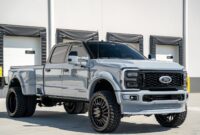80s Ford Trucks For Sale: A Comprehensive Buyer’s Guide sale.truckstrend.com
In an era defined by big hair, bold fashion, and even bolder automotive designs, the 1980s produced some of the most enduring and beloved vehicles on American roads. Among them, the Ford truck stands as an undisputed icon. Rugged, dependable, and imbued with a distinctive character, 80s Ford trucks — spanning the 7th and 8th generations of the F-Series and the Bronco — have cemented their place in automotive history. Today, these vintage workhorses are more than just old vehicles; they are sought-after collector’s items, versatile project platforms, and even reliable daily drivers for those who appreciate their timeless appeal and straightforward mechanics.
If you’re considering diving into the world of classic trucks, specifically the blue-oval offerings from the 1980s, you’re in for a treat. This comprehensive guide will walk you through everything you need to know about finding, evaluating, and purchasing an 80s Ford truck for sale, ensuring you make an informed decision and embark on a rewarding ownership journey.
80s Ford Trucks For Sale: A Comprehensive Buyer’s Guide
Why Buy an 80s Ford Truck? The Enduring Appeal
The allure of an 80s Ford truck goes far beyond mere nostalgia. There are several compelling reasons why these vehicles continue to attract a passionate following:
- Durability and Simplicity: Unlike modern trucks laden with complex electronics, 80s Fords were built with mechanical robustness in mind. Their simpler designs make them easier and often cheaper to maintain and repair for the average enthusiast or backyard mechanic.
- Classic Styling: The squared-off lines, prominent grilles, and utilitarian aesthetics of 80s Ford trucks exude a timeless charm. Whether you prefer the "Bullnose" or "Bricknose" design, these trucks possess a distinctive character that stands out in a sea of contemporary vehicles.
- Value Retention and Potential Appreciation: While not all models are skyrocketing in value, clean, well-maintained examples, especially 4x4s and specific trims, have shown strong value retention and even appreciation. They can be a fun investment as well as a practical vehicle.
- Versatility: From hauling lumber and tackling off-road trails to serving as a unique daily driver or a canvas for custom modifications, an 80s Ford truck is incredibly versatile. They truly embody the "Built Ford Tough" ethos.
- Strong Community and Parts Availability: Ford trucks from this era sold in vast numbers, leading to an extensive aftermarket and a thriving community of owners and enthusiasts. Parts, both new and used, are generally easy to find, and online forums and clubs offer invaluable support and knowledge.

Understanding the Generations: 7th Gen (1980-1986) vs. 8th Gen (1987-1991)
The 1980s saw two distinct generations of Ford F-Series trucks, each with its own characteristics:
7th Generation (1980-1986): The "Bullnose"
- Key Characteristics: This generation introduced a more aerodynamic design than its predecessors, though it retained a notably square, chiseled look. Known affectionately as the "Bullnose" due to its prominent, somewhat protruding grille, these trucks feature a more traditional, blocky interior.
- Engine Options: A wide array of engines were available, including the legendary 300 cubic inch (4.9L) inline-six, and various V8s like the 302 (5.0L), 351W (5.8L), 400 (6.6L – early years), and the potent 460 (7.5L). Diesel options included the robust 6.9L IDI (Indirect Injection Diesel) Navistar engine starting in 1983.
- Models: F-100 (phased out by 1983), F-150, F-250, F-350, and the full-size Bronco.
- Why Buy: If you prefer a more classic, utilitarian feel and don’t mind carbureted engines (though some later models did get throttle body injection), the Bullnose offers raw, mechanical charm.


8th Generation (1987-1991): The "Bricknose"
- Key Characteristics: While still fundamentally square, the 8th generation, dubbed the "Bricknose," featured a more integrated, flush grille and headlight design, giving it a slightly more modern and aerodynamic appearance. The interior received a significant update, offering improved ergonomics and a more contemporary feel.
- Engine Options: This generation largely standardized Electronic Fuel Injection (EFI) across its gasoline engine lineup (302, 351W, 460), improving reliability, cold starts, and fuel efficiency over carburetors. The diesel option evolved into the 7.3L IDI.
- Models: F-150, F-250, F-350, and the full-size Bronco.
- Why Buy: If you want the classic 80s look with the added benefits of EFI (easier starting, smoother running, better economy), the Bricknose is an excellent choice. Its updated interior is also a plus for those seeking more comfort.
What to Look For: Key Inspection Points Before Buying
Purchasing any used vehicle requires diligence, but with a vintage truck, specific areas demand extra attention. Here’s a checklist:
- Rust: This is the ultimate killer of old trucks. Inspect common rust areas thoroughly:
- Body Panels: Cab corners, rocker panels, wheel wells (especially rear), fenders, bed sides, tailgate.
- Frame: Check the entire frame for cracks, significant surface rust that has become pitting, or previous repair attempts. Pay attention to spring hangers and body mounts.
- Floor Pans & Firewall: Check from inside and underneath.
- Engine and Transmission:
- Cold Start: Listen for knocking, excessive smoke (blue for oil, white for coolant, black for rich fuel).
- Fluid Leaks: Check under the truck for oil, transmission fluid, coolant, or power steering leaks.
- Transmission: Manuals should shift smoothly without grinding. Automatics should shift cleanly, without harsh jerks or slipping. Check fluid condition (should be reddish, not burnt brown).
- Engine Bay: Look for signs of neglect, frayed wires, patched hoses, or poorly executed modifications.
- Suspension and Steering:
- Steering Play: Excessive play in the steering wheel indicates worn steering box or linkage components.
- Suspension: Look for sagging (especially front coil springs), worn bushings, leaky shocks, or broken leaf springs. Drive over bumps to check for excessive bouncing or clunking.
- Brakes:
- Check for firm pedal feel. Spongy pedal or pulling to one side indicates issues.
- Inspect brake lines for corrosion, calipers for leaks, and drum brakes for proper adjustment.
- Electrical System: Test all lights (headlights, tail lights, turn signals), wipers, horn, radio, power windows (if equipped), and HVAC fan. Simpler wiring means easier diagnosis but still potential for issues.
- Interior Condition: Assess the seats for tears or significant wear, dashboard for cracks, headliner for sagging, and carpet for excessive staining or mold. These can be expensive to restore.
- Documentation: Always request the title to ensure it’s clear (not salvage or rebuilt). Service records, if available, can provide valuable insight into the truck’s history and maintenance.
Where to Find 80s Ford Trucks For Sale
The hunt for your perfect 80s Ford truck can be an adventure in itself:
- Online Marketplaces: Websites like Facebook Marketplace, Craigslist, and eBay Motors are prime hunting grounds. Set up search alerts for new listings.
- Classic Car Dealerships/Specialty Dealers: These outlets often have higher-quality, fully restored, or well-maintained examples, but at a premium price.
- Auctions: Major auctions like Mecum and Barrett-Jackson occasionally feature pristine examples, while local auctions can be a source for project vehicles.
- Local Classifieds and Word of Mouth: Don’t underestimate the power of local newspapers, bulletin boards, or simply asking around. Many great finds happen this way.
- Specialized Forums and Communities: Online forums dedicated to 80s Ford trucks (e.g., Ford-Trucks.com, FullSizeBronco.com) often have "for sale" sections where enthusiasts sell their vehicles directly.
Pricing and Value: What to Expect
The price of an 80s Ford truck can vary wildly based on several factors: condition, mileage, engine type, transmission, trim level (e.g., XLT Lariat, Custom), 2WD vs. 4WD, geographical location, and any modifications or restoration work.
- Project Trucks ($1,000 – $5,000): These will typically need significant work (rust repair, engine/transmission rebuilds, interior overhaul). Best for those with mechanical skills and a dedicated budget for parts and time.
- Driver Quality ($5,000 – $15,000): Trucks in this range are generally running and driving reliably, with minimal rust and a decent interior. They might have minor issues or cosmetic flaws but are ready to enjoy.
- Clean/Show Quality ($15,000+): These are meticulously maintained, often restored, or exceptionally low-mileage examples. They are ready for car shows and command top dollar. Highly desirable 4×4 models, Broncos, or trucks with specific engine/transmission combos (e.g., 460 V8 with manual transmission) can exceed this range.
Always factor in the cost of a pre-purchase inspection by a trusted mechanic, especially for higher-priced vehicles.
Common Challenges and Solutions
Owning an 80s Ford truck is incredibly rewarding, but it comes with its own set of considerations:
- Parts Availability: While mechanical parts are generally abundant, specific interior trim pieces, unique emblems, or certain body panels can be harder to source.
- Solution: Utilize online retailers (LMC Truck, Dennis Carpenter), junkyards, specialized forums, and online communities for rare parts.
- Fuel Economy: These trucks were not designed for efficiency. Expect single-digit to low-teen MPG, especially with larger engines and 4×4.
- Solution: Budget for fuel costs. EFI models (87-91) generally offer slightly better economy than carbureted ones. Overdrive transmissions (AOD, ZF5) also help on the highway.
- Safety Features: Compared to modern vehicles, 80s trucks have minimal safety features (no airbags, basic crumple zones).
- Solution: Drive defensively. Consider upgrading brakes and tires for better stopping power.
- Emissions Regulations: Some states or regions have stricter emissions laws for older vehicles.
- Solution: Check local regulations before buying, especially if you plan engine swaps or modifications. EFI trucks generally pass emissions easier than carbureted ones.
- Insurance: Standard insurance might be expensive.
- Solution: Look into classic car insurance providers (e.g., Hagerty, Grundy) which often offer better rates and agreed-upon value coverage for vintage vehicles.
Price Table: Estimated Values for 80s Ford Trucks
The following table provides a general guide for 80s Ford trucks for sale. Prices are highly variable based on specific condition, mileage, options, and market demand.
| Model / Year Range | Engine Type (Common) | Drivetrain (Common) | Condition: Project (Needs Work) | Condition: Driver (Good Running) | Condition: Clean (Excellent) | Key Factors Affecting Price |
| :—————– | :——————- | :—————— | :——————————- | :——————————- | :————————— | :——————————————————————————————————————————————————————————————————————————————————————————————————————————————————————————————————————————————————————————————————————————————————————————————————————————————————————————————————————————————————————————————————————————————————————————————————————————————————————————————————————————————————————————————————————————————————————————————————————————————————————————————————————————————————————————————————————————————————————————————————————————————————————————————————————————————————————————————————————————————————————————————————————————————————————————————————————————————————————————————————————————————————————————————————————————————————————————————————————————————————————————————————————————————————————————————————————————————————————————————————————————————————————————————————————————————————————————————————————————————————————————————————————————————————————————————————————————————————————————————————————————————————————————————————————————————————————————————————————————————————————————————————————————————————————————————————————————————————————————————————————————————————————————————————————————————————————————————————————————————————————————————————————————————————————————————————————————————————————————————————————————————————————————————————————————————————————————————————————————————————————————————————————————————————————————————————————————————————————————————————————————————————————————————————————————————————————————————————————————————————————————————————————————————————————————————————————————————————————————————————————————————————————————————————————————————————————————————————————————————————————————————————————————————————————————————————————————————————————————————————————————————————————————————————————————————————————————————————————————————————————————————————————————————————————————————————————————————————————————————————————————————————————————————————————————————————————————————————————————————————————————————————————————————————————————————————————————————————————————————————————————————————————————————————————————————————————————————————————————————————————————————————————————————————————————————————————————————————————————————————————————————————————————————————————————————————————————————————————————————————————————————————————————————————————————————————————————————————————————————————————————————————————————————————————————————————————————————————————————————————————————————————————————————————————————————————————————————————————————————————————————————————————————————————————————————————————————————————————————————————————————————————————————————————————————————————————————————————————————————————————————————————————————————————————————————————————————————————————————————————————————————————————————————————————————————————————————————————————————————————————————————————————————————————————————————————————————————————————————————————————————————————————————————————————————————————————————————————————————————————————————————————————————————————————————————————————————————————————————————————————————————————————————————————————————————————————————————————————————————————————————————————————————————————————————————————————————————————————————————————————————————————————————————————————————————————————————————————————————————————————————————————————————————————————————————————————————————————————————————————————————————————————————————————————————————————————————————————————————————————————————————————————————————————————————————————————————————————————————————————————————————————————————————————————————————————————————————————————————————————————————————————————————————————————————————————————————————————————————————————————————————————————————————————————————————————————————————————————————————————————————————————————————————————————————————————————————————————————————————————————————————————————————————————————————————————————————————————————————————————————————————————————————————————————————————————————————————————————————————————————————————————————————————————————————————————————————————————————————————————————————————————————————————————————————————————————————————————————————————————————————————————————————————————————————————————————————————————————————————————————————————————————————————————————————————————————————————————————————————————————————————————————————————————————————————————————————————————————————————————————————————————————————————————————————————————————————————————————————————————————————————————————————————————————————————————————————————————————————————————————————————————————————————————————————————————————————————————————————————————————————————————————————————————————————————————————————————————————————————————————————————————————————————————————————————————————————————————————————————————————————————————————————————————————————————————————————————————————————————————————————————————————————————————————————————————————————————————————————————————————————————————————————————————————————————————————————————————————————————————————————————————————————————————————————————————————————————————————————————————————————————————————————————————————————————————————————————————————————————————————————————————————————————————————————————————————————————————————————————————————————————————————————————————————————————————————————————————————————————————————————————————————————————————————————————————————————————————————————————————————————————————————————————————————————————————————————————————————————————————————————————————————————————————————————————————————————————————————————————————————————————————————————————————————————————————————————————————————————————————————————————————————————————————————————————————————————————————————————————————————————————————————————————————————————————————————————————————————————————————————————————————————————————————————————————————————————————————————————————————————————————————————————————————————————————————————————————————————————————————————————————————————————————————————————————————————————————————————————————————————————————————————————————————————————————————————————————————————————————————————————————————————————————————————————————————————————————————————————————————————————————————————————————————————————————————————————————————————————————————————————————————————————————————————————————————————————————————————————————————————————————————————————————————————————————————————————————————————————————————————————————————————————————————————————————————————————————————————————————————————————————————————————————————————————————————————————————————————————————————————————————————————————————————————————————————————————————————————————————————————————————————————————————————————————————————————————————————————————————————————————————————————————————————————————————————————————————————————————————————————————————————————————————————————————————————————————————————————————————————————————————————————————————————————————————————————————————————————————————————————————————————————————————————————————————————————————————————————————————————————————————————————————————————————————————————————————————————————————————————————————————————————————————————————————————————————————————————————————————————————————————————————————————————————————————————————————————————————————————————————————————————————————————————————————————————————————————————————————————————————————————————————————————————————————————————————————————————————————————————————————————————————————————————————————————————————————————————————————————————————————————————————————————————————————————————————————————————————————————————————————————————————————————————————————————————————————————————————————————————————————————————————————————————————————————————————————————————————————————————————————————————————————————————————————————————————————————————————————————————————————————————————————————————————————————————————————————————————————————————————————————————————————————————————————————————————————————————————————————————————————————————————————————————————————————————————————————————————————————————————————————————————————————————————————————————————————————————————————————————————————————————————————————————————————————————————————————————————————————————————————————————————————————————————————————————————————————————————————————————————————————————————————————————————————————————————————————————————————————————————————————————————————————————————————————————————————————————————————————————————————————————————————————————————————————————————————————————————————————————————————————————————————————————————————————————————————————————————————————————————————————————————————————————————————————————————————————————————————————————————————————————————————————————————————————————————————————————————————————————————————————————————————————————————————————————————————————————————————————————————————————————————————————————————————————————————————————————————————————————————————————————————————————————————————————————————————————————————————————————————————————————————————————————————————————————————————————————————————————————————————————————————————————————————————————————————————————————————————————————————————————————————————————————————————————————————————————————————————————————————————————————————————————————————————————————————————————————————————————————————————————————————————————————————————————————————————————————————————————————————————————————————————————————————————————————————————————————————————————————————————————————————————————————————————————————————————————————————————————————————————————————————————————————————————————————————————————————————————————————————————————————————————————————————————————————————————————————————————————————————————————————————————————————————————————————————————————————————————————————————————————————————————————————————————————————————————————————————————————————————————————————————————————————————————————————————————————————————————————————————————————————————————————————————————————————————————————————————————————————————————————————————————————————————————————————————————————————————————————————————————————————————————————————————————————————————————————————————————————————————————————————————————————————————————————————————————————————————————————————————————————————————————————————————————————————————————————————————————————————————————————————————————————————————————————————————————————————————————————————————————————————————————————————————————————————————————————————————————————————————————————————————————————————————————————————————————————————————————————————————————————————————————————————————————————————————————————————————————————————————————————————————————————————————————————————————————————————————————————————————————————————————————————————————————————————————————————————————————————————————————————————————————————————————————————————————————————————————————————————————————————————————————————————————————————————————————————————————————————————————————————————————————————————————————————————————————————————————————————————————————————————————————————————————————————————————————————————————————————————————————————————————————————————————————————————————————————————————————————————————————————————————————————————————————————————————————————————————————————————————————————————————————————————————————————————————————————————————————————————————————————————————————————————————————————————————————————————————————————————————————————————————————————————————————————————————————————————————————————————————————————————————————————————————————————————————————————————————————————————————————————————————————————————————————————————————————————————————————————————————————————————————————————————————————————————————————————————————————————————————————————————————————————————————————————————————————————————————————————————————————————————————————————————————————————————————————————————————————————————————————————————————————————————————————————————————————————————————————————————————————————————————————————————————————————————————————————————————————————————————————————————————————————————————————————————————————————————————————————————————————————————————————————————————————————————————————————————————————————————————————————————————————————————————————————————————————————————————————————————————————————————————————————————————————————————————————————————————————————————————————————————————————————————————————————————————————————————————————————————————————————————————————————————————————————————————————————————————————————————————————————————————————————————————————————————————————————————————————————————————————————————————————————————————————————————————————————————————————————————————————————————————————————————————————————————————————————————————————————————————————————————————————————————————————————————————————————————————————————————————————————————————————————————————————————————————————————————————————————————————————————————————————————————————————————————————————————————————————————————————————————————————————————————————————————————————————————————————————————————————————————————————————————————————————————————————————————————————————————————————————————————————————————————————————————————————————————————————————————————————————————————————————————————————————————————————————————————————————————————————————————————————————————————————————————————————————————————————————————————————————————————————————————————————————————————————————————————————————————————————————————————————————————————————————————————————————————————————————————————————————————————————————————————————————————————————————————————————————————————————————————————————————————————————————————————————————————————————————————————————————————————————————————————————————————————————————————————————————————————————————————————————————————————————————————————————————————————————————————————————————————————————————————————————————————————————————————————————————————————————————————————————————————————————————————————————————————End of Article
<article>
<h1>80s Ford Trucks For Sale</h1>
<section>
<h2>An Enduring Icon: Why 80s Ford Trucks Still Command Attention</h2>
<p>The 1980s. A decade synonymous with bold statements, groundbreaking music, and a distinct shift in automotive design. While pop culture trends have come and gone, the Ford trucks of this era have remained steadfast in their appeal. From the rugged F-Series workhorses to the adventurous Bronco, 80s Ford trucks represent a unique blend of no-nonsense utility, classic American styling, and surprising reliability that continues to resonate with enthusiasts, collectors, and practical buyers alike. They are not merely old vehicles; they are a tangible link to a simpler time, a testament to Ford's "Built Ford Tough" philosophy, and for many, a highly sought-after piece of automotive history that’s increasingly becoming a shrewd investment.</p>
<p>This comprehensive guide delves into the world of 80s Ford trucks for sale, offering insights into what makes them so desirable, what to look for when buying, where to find them, and what to expect in terms of pricing and ownership challenges. Whether you're a seasoned mechanic looking for a project, a nostalgic enthusiast yearning for a piece of your past, or simply someone seeking a robust, characterful vehicle that stands apart from modern offerings, the 80s Ford truck market offers a treasure trove of possibilities.</p>
</section>
<section>
<h2>The Enduring Appeal: Why Buy an 80s Ford Truck Today?</h2>
<p>The decision to purchase a vintage vehicle often stems from a desire for something different, something with character. 80s Ford trucks deliver this in spades, along with several practical advantages that make them a compelling choice in today's market:</p>
<ul>
<li><strong>Unmatched Durability and Simplicity:</strong> In an age of complex computer systems and integrated electronics, 80s Ford trucks stand out for their mechanical straightforwardness. Fewer sensors and simpler wiring mean fewer points of failure and, crucially, easier diagnosis and repair for the average individual. These trucks were built to work hard and last, often running for hundreds of thousands of miles with proper maintenance.</li>
<li><strong>Timeless, Iconic Styling:</strong> The distinctive, square-body aesthetic of 80s Ford trucks is instantly recognizable and widely admired. Whether it's the prominent grille of the "Bullnose" or the more integrated design of the "Bricknose," their utilitarian lines have aged gracefully, offering a refreshing contrast to the often-overstyled modern truck designs. Owning one is a statement.</li>
<li><strong>Strong Value Retention and Appreciation Potential:</strong> While not every 80s Ford truck will become a high-value collector's item, clean, well-maintained examples – particularly 4x4 models, specific engine/transmission combinations, and Broncos – have shown consistent appreciation. They represent a tangible asset that can provide both utility and a decent return on investment over time.</li>
<li><strong>Exceptional Versatility:</strong> These trucks are true multi-taskers. They excel as rugged work vehicles, capable off-roaders, stylish daily drivers, or perfect platforms for custom builds, restorations, or even overland adventures. Their robust chassis and powerful engines make them adaptable to almost any need.</li>
<li><strong>Vibrant Community and Accessible Parts:</strong> Due to their immense popularity when new, the aftermarket for 80s Ford trucks is robust. Parts, from mechanical components to body panels and interior pieces, are generally easy to find, often at reasonable prices. Furthermore, a passionate community of owners, online forums, and specialized clubs provides invaluable technical support, shared knowledge, and camaraderie.</li>
</ul>
</section>
<section>
<h2>Navigating the Decades: 7th Gen (1980-1986) vs. 8th Gen (1987-1991)</h2>
<p>The 1980s were a transitional period for Ford trucks, featuring two distinct generations of the F-Series that offer different aesthetics and mechanical nuances. Understanding these differences is key to finding the right truck for you.</p>
<h3>7th Generation (1980-1986): The "Bullnose"</h3>
<p>The start of the decade brought the 7th generation F-Series, affectionately known as the "Bullnose" due to its squared-off, prominent grille that protrudes slightly. These trucks embodied a more traditional, rugged aesthetic, building on Ford's reputation for durability. The exterior featured sharp lines and a no-frills, functional design, while the interior was utilitarian but comfortable for its time. Engine options were plentiful, including the venerable 300 cubic inch (4.9L) inline-six, known for its bulletproof reliability and torque. V8 options included the 302 (5.0L), 351W (5.8L), and the powerful 460



